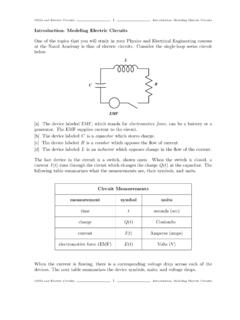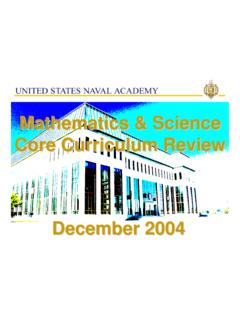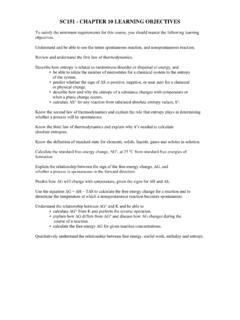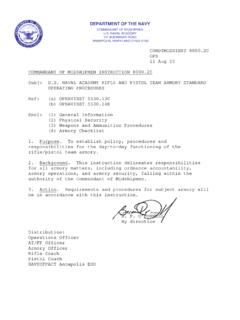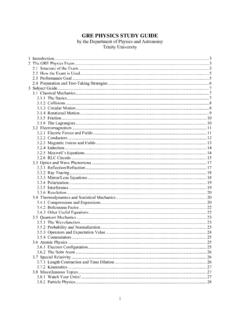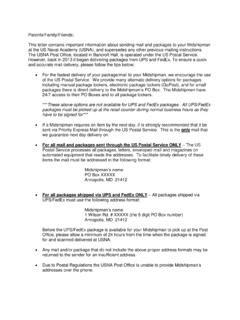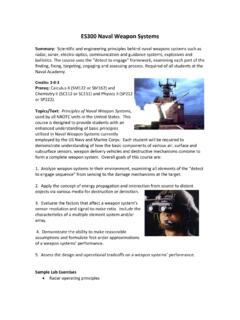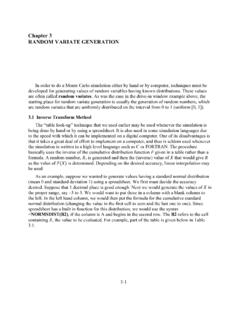Transcription of CORROSION BASICS - United States Naval Academy
1 CORROSION BASICS (from Swain (1996) and Schultz (1997)) What is CORROSION ? Webster s Dictionary - corrode (v.) To eat away or be eaten away gradually, especially by chemical action. NACE CORROSION BASICS - CORROSION may be defined as the deterioration of a material (usually a metal) because of a reaction with the environment. Why do metals corrode? Most metals are found in nature as ores. The manufacturing process of converting these ores into metals involves the input of energy. During the CORROSION reaction the energy added in manufacturing is released, and the metal is returned to its oxide state. ProductsCorrosion Metal Ore Metalelectrons) (strip oxidation electrons) (add reduction In the marine environment, the CORROSION process generally takes place in aqueous solutions and is therefore electrochemical in nature.
2 CORROSION consequences Economic - CORROSION results in the loss of $8 - $126 billion annually in the alone. This impact is primarily the result of: 1. Downtime 2. Product Loss 3. Efficiency Loss 4. Contamination 5. Overdesign Safety / Loss of Life CORROSION can lead to catastrophic system failures which endanger human life and health. Examples include a 1967 bridge collapse in West Virginia which killed 46. The collapse was attributed to stress CORROSION cracking (SCC). In another example, the fuselage of an airliner in Hawaii ripped open due to the combined action of stress and atmospheric CORROSION . 2 CORROSION cell CORROSION occurs due to the formation of electrochemical cells.
3 In order for the CORROSION reaction to occur five things are necessary. If any of these factors are eliminated, galvanic CORROSION will not occur. THIS IS THE KEY TO CORROSION CONTROL! The necessary factors for CORROSION to proceed are: 1. ANODE - the metal or site on the metal where oxidation occurs (loss of electrons). The anode has a more negative potential with respect to (wrt) the cathode and is termed less noble wrt the cathode . 2. cathode - the metal or site on the metal where reduction occurs (gain of electrons). The cathode has a more positive potential wrt the anode and is termed more noble wrt the anode. 3. ELECTROLYTE - the electrically conductive medium in which the anode and cathode reside.
4 4. ELECTRICAL CONNECTION - the anode and the cathode must be electrically connected. 5. POTENTIAL DIFFERENCE - a voltage difference must exist between the anode and the cathode . Schematic of the CORROSION cell 3 The electrochemical cell is driven by the potential difference between the anode and the cathode . This causes a current to flow, the magnitude of which will be determined by the resistance of the electrochemical circuit ( Ohm s Law, I=V/R). The three main types of electrochemical cells are: Concentration Cells - this is where the anode and the cathode are the same material, but concentrations of reactants and therefore potential differ at the electrodes.
5 These can be oxygen concentration or metal ion concentration cells. Bimetallic Cells - where the anode and cathode are different materials. Thermo-galvanic Cells - where the anode and the cathode are of the same material and the composition of the electrolyte is the same but the temperature at the electrodes are different. In the CORROSION cell, metal ions formed from metal oxidation (cations) migrate from the anode to the cathode through the electrolyte. The electrons given off by this oxidation reaction move from the anode to the cathode through the electrical connection. Current flows from cathode to the anode through the electrical connection and from the anode to the cathode in the electrolyte.
6 Surface potential The surface potential of a metal is a measure of its activity. When a metal is immersed in an aqueous environment, both oxidation and reduction reactions occur until some equilibrium is reached. These reactions tend to create an electrical double layer at the surface which establish an electrical potential. The more positive metals are said to be more noble and less reactive, while the more negative metals are called base metals and are highly reactive. The standard potential of metals are given in the following table termed the standard electromotive force series. It should be made clear however that a metal s actual potential can be greatly altered by its environment.
7 4 Standard EMF Series Table [from Jones (1996)] 5 Anode half-cell reaction Oxidation of the metal at the anode may be expressed by the following half-cell reaction: ++ neMMn cathode half-cell reaction The reduction half-cell reaction at the cathode depends mainly on environmental conditions. The following six reactions represent common cathodic reactions along with the conditions in which they generally occur: 1. ++OHeOHO44222 aerated neutral to alkaline water 2. OHeHO22244 ++ + aerated acidic solutions 3. + +222 HeH hydrogen evolution (in acids) 4. MneMn + + metal deposition 5. + + +)1(nnMeM metal reduction Example: Magnesium is submerged into a bath of HCl.
8 What would the predominate anodic and cathodic reactions be? Anodic ++ eMgMg22 Cathodic + +222 HeH Overall reaction + +222 HMgClHClMg 6 CORROSION thermodynamics As we have observed, CORROSION reactions inevitably involve electron transfer. For this reason, the reactions may be considered electrochemical in nature. Thermodynamics can provide a basis for the understanding of the energy changes associated with the CORROSION reaction. It can, in general, predict when CORROSION is possible. Thermodynamics cannot predict CORROSION rates. The rate at which the reaction proceeds is governed by kinetics. The Gibb s free energy, given by the following equation, provides us a tool with which to predict if a CORROSION reaction is thermodynamically possible: (volts) cell half anodefor potential Standard(volts) cell half cathodefor potential Standard (volts) = potential emf Standard )e mol-J/v (96,500constant sFaraday' )e (molreaction oxidation in d transfereelectrons(Joules)energy free sGibb' :-00oxox--==+==== = EEEEEFnGwherenFEGooredred If G is positive, the reaction will not proceed.
9 If G is negative, the reaction is possible. Example: Steel is placed in aerated seawater with a neutral pH. Is CORROSION of the steel possible, why? (Assume valence of 2) Anodic ++ eFeFe22 Eoxo = v Cathodic ++OHeOHO44222 Eredo = v Overall reaction ()222222 OHFeOHOFe ++ E = Eoxo + Eredo E = v GnFE=- J 244,531 - v))( e mol-J/v )(96,500e mol -(2--= = GG negative sign indicates CORROSION reaction, as written, is possible 7 It should be stated that potential values of a metal are modified by the environment. Concentrations of anodic and cathodic reactants will alter the balance between the oxidation and reduction reactions. The Nernst equation allows us to calculate metal potentials under differing metal ion or oxidation/reduction conditions.
10 The Nernst equation may be stated as follows: [][ ][][ ](M) species reduced ofactivity .(M) species oxidized ofactivity .)e olcoulombs/m (96,500constant sFaraday' )e (molreaction in the d transfereelectronsKelvin) (degrees re temperatuAbsolute K) J/mol ( gas Universal(volts)activity unit and C25 @ potentialreduction Standard (volts) conditons talenvironmenunder potential Cell :.. +=redoxidFnTREE whereredoxidnFRTEE ocellocell At standard temperature and pressure (25oC and 760mm Hg) this may be simplified to the following: [][ ].. += The Nernst equation can also be written for each half cell as is shown in the following metal ion concentration cell example.
